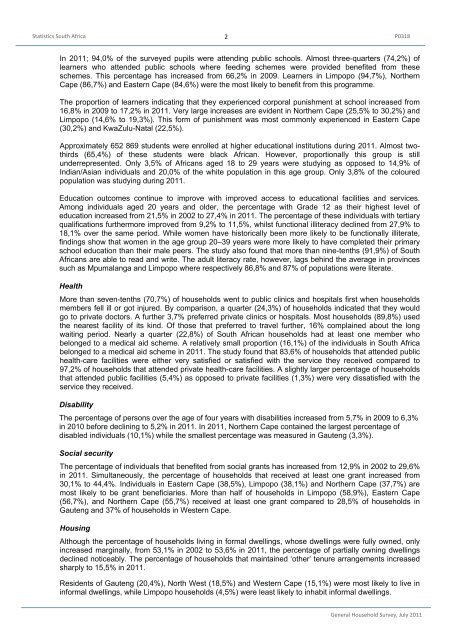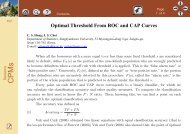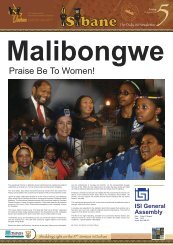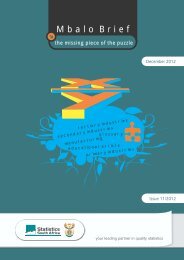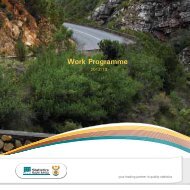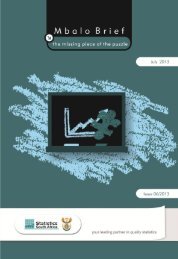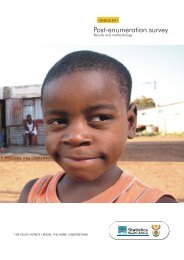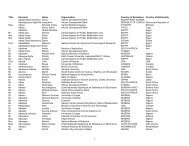General household survey - Statistics South Africa
General household survey - Statistics South Africa
General household survey - Statistics South Africa
Create successful ePaper yourself
Turn your PDF publications into a flip-book with our unique Google optimized e-Paper software.
<strong>Statistics</strong> <strong>South</strong> <strong>Africa</strong> 2<br />
P0318<br />
In 2011; 94,0% of the <strong>survey</strong>ed pupils were attending public schools. Almost three-quarters (74,2%) of<br />
learners who attended public schools where feeding schemes were provided benefited from these<br />
schemes. This percentage has increased from 66,2% in 2009. Learners in Limpopo (94,7%), Northern<br />
Cape (86,7%) and Eastern Cape (84,6%) were the most likely to benefit from this programme.<br />
The proportion of learners indicating that they experienced corporal punishment at school increased from<br />
16,8% in 2009 to 17,2% in 2011. Very large increases are evident in Northern Cape (25,5% to 30,2%) and<br />
Limpopo (14,6% to 19,3%). This form of punishment was most commonly experienced in Eastern Cape<br />
(30,2%) and KwaZulu-Natal (22,5%).<br />
Approximately 652 869 students were enrolled at higher educational institutions during 2011. Almost twothirds<br />
(65,4%) of these students were black <strong>Africa</strong>n. However, proportionally this group is still<br />
underrepresented. Only 3,5% of <strong>Africa</strong>ns aged 18 to 29 years were studying as opposed to 14,9% of<br />
Indian/Asian individuals and 20,0% of the white population in this age group. Only 3,8% of the coloured<br />
population was studying during 2011.<br />
Education outcomes continue to improve with improved access to educational facilities and services.<br />
Among individuals aged 20 years and older, the percentage with Grade 12 as their highest level of<br />
education increased from 21,5% in 2002 to 27,4% in 2011. The percentage of these individuals with tertiary<br />
qualifications furthermore improved from 9,2% to 11,5%, whilst functional illiteracy declined from 27,9% to<br />
18,1% over the same period. While women have historically been more likely to be functionally illiterate,<br />
findings show that women in the age group 20–39 years were more likely to have completed their primary<br />
school education than their male peers. The study also found that more than nine-tenths (91,9%) of <strong>South</strong><br />
<strong>Africa</strong>ns are able to read and write. The adult literacy rate, however, lags behind the average in provinces<br />
such as Mpumalanga and Limpopo where respectively 86,8% and 87% of populations were literate.<br />
Health<br />
More than seven-tenths (70,7%) of <strong>household</strong>s went to public clinics and hospitals first when <strong>household</strong>s<br />
members fell ill or got injured. By comparison, a quarter (24,3%) of <strong>household</strong>s indicated that they would<br />
go to private doctors. A further 3,7% preferred private clinics or hospitals. Most <strong>household</strong>s (89,8%) used<br />
the nearest facility of its kind. Of those that preferred to travel further, 16% complained about the long<br />
waiting period. Nearly a quarter (22,8%) of <strong>South</strong> <strong>Africa</strong>n <strong>household</strong>s had at least one member who<br />
belonged to a medical aid scheme. A relatively small proportion (16,1%) of the individuals in <strong>South</strong> <strong>Africa</strong><br />
belonged to a medical aid scheme in 2011. The study found that 83,6% of <strong>household</strong>s that attended public<br />
health-care facilities were either very satisfied or satisfied with the service they received compared to<br />
97,2% of <strong>household</strong>s that attended private health-care facilities. A slightly larger percentage of <strong>household</strong>s<br />
that attended public facilities (5,4%) as opposed to private facilities (1,3%) were very dissatisfied with the<br />
service they received.<br />
Disability<br />
The percentage of persons over the age of four years with disabilities increased from 5,7% in 2009 to 6,3%<br />
in 2010 before declining to 5,2% in 2011. In 2011, Northern Cape contained the largest percentage of<br />
disabled individuals (10,1%) while the smallest percentage was measured in Gauteng (3,3%).<br />
Social security<br />
The percentage of individuals that benefited from social grants has increased from 12,9% in 2002 to 29,6%<br />
in 2011. Simultaneously, the percentage of <strong>household</strong>s that received at least one grant increased from<br />
30,1% to 44,4%. Individuals in Eastern Cape (38,5%), Limpopo (38,1%) and Northern Cape (37,7%) are<br />
most likely to be grant beneficiaries. More than half of <strong>household</strong>s in Limpopo (58,9%), Eastern Cape<br />
(56,7%), and Northern Cape (55,7%) received at least one grant compared to 28,5% of <strong>household</strong>s in<br />
Gauteng and 37% of <strong>household</strong>s in Western Cape.<br />
Housing<br />
Although the percentage of <strong>household</strong>s living in formal dwellings, whose dwellings were fully owned, only<br />
increased marginally, from 53,1% in 2002 to 53,6% in 2011, the percentage of partially owning dwellings<br />
declined noticeably. The percentage of <strong>household</strong>s that maintained ‘other’ tenure arrangements increased<br />
sharply to 15,5% in 2011.<br />
Residents of Gauteng (20,4%), North West (18,5%) and Western Cape (15,1%) were most likely to live in<br />
informal dwellings, while Limpopo <strong>household</strong>s (4,5%) were least likely to inhabit informal dwellings.<br />
<strong>General</strong> Household Survey, July 2011


